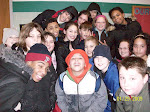Podcasting is an excellent new tool that introduces multimedia publishing through video, photo, and audio devises. Podcast Pickle offers podcasts and videocasts to a wide community of viewers. You can watch podcasts that are about various topics including comedy, social studies, sports, books, music, art, science, and many more. Pickle offers a clear search criterion that assists you in easily locating podcasts that you are looking for. After you view a podcast you can view another or you can subscribe to receive every episode. If you subscribe to a post the new episodes will automatically download to your iPod, or mp3 player as become available. You can also produce your own podcast about your interests and share.
Podcasting would be an excellent resource in the classroom to use as an assessment. After a science chapter has been covered about weather students could make a podcast about the weather forecast. In social studies students could do a news report during a time period in US history being learned. Students could do oral history interviews and broadcast their information to share and learn from each other about their interviews information.
Students frequently construct their learning and understanding through doing. Developing podcasts that demonstrate students levels of comprehension in content areas would be an excellent method of assessment. In addition students are able to learn from each others podcasts, which is motivation, interest driven, and current to their needs as learners.
Lastly, the information that is available through Podcasting introduces several teaching resources that can be implemented for instruction. I was easily able to find a podcast about the United States regions, Physical Science, and character education which are all current curriculum that is being instructed in my class. Knowing the endless and fresh information that is available through Podcasting encourages me as a teacher to take risks to show podcasts, critique their information, and have students produce their own podcasts.
Once again, a Web 2.0 resource is encouraging communication, collaboration, networking, and interaction.
It’s Tuesday: Join Us for a Slice of Life!
15 hours ago






